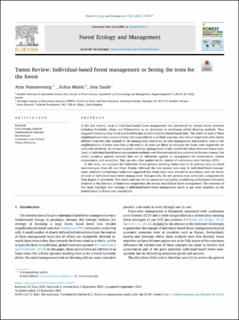| dc.contributor.author | Pommerening, Arne | |
| dc.contributor.author | Maleki, Kobra | |
| dc.contributor.author | Haufe, Jens | |
| dc.date.accessioned | 2021-10-19T18:15:10Z | |
| dc.date.available | 2021-10-19T18:15:10Z | |
| dc.date.created | 2021-09-27T09:44:35Z | |
| dc.date.issued | 2021-09-15 | |
| dc.identifier.citation | Forest Ecology and Management. 2021, 501 1-12. | en_US |
| dc.identifier.issn | 0378-1127 | |
| dc.identifier.uri | https://hdl.handle.net/11250/2823957 | |
| dc.description.abstract | In the last century, local or individual-based forest management was introduced by various forest scientists including Schädelin, Abetz and Pollanschütz as an alternative to traditional global thinning methods. They suggested breaking large forest stands down into smaller neighbourhood-based units. The centre of each of these neighbourhood-based units is a frame tree (also referred to as final crop tree, elite tree or target tree) with clearly defined properties that depend on the management objectives. In each management intervention, trees in the neighbourhood of frame trees that in the next 5–10 years are likely to influence the frame trees negatively are removed selectively. In contrast to global methods, management is only carried out where there are frame trees. Local or individual-based forest management methods were first introduced in a commercial forestry context, but rather constitute generic methods that can be efficiently applied in management for conservation, carbon sequestration and recreation. They are also often applied in the context of continuous cover forestry (CCF). In this study, we analysed the behaviour of test persons selecting frame trees in 26 training sites, so-called marteloscopes, from all over Great Britain. Although the test persons were new to individual-based management, statistical performance indicators suggested that frame trees were selected in accordance with the theory of local or individual-based forest management. Unexpectedly the test persons even achieved a comparatively high degree of agreement. This result contrasts the low agreement and partly unsatisfying performance indicators incurred in the selection of frame-tree competitors, the second step of local forest management. The outcomes of this study highlight that training in individual-based forest management needs to put more emphasis on the identification of frame-tree competitors. | en_US |
| dc.language.iso | eng | en_US |
| dc.publisher | Elsevier B.V. | en_US |
| dc.rights | Navngivelse 4.0 Internasjonal | * |
| dc.rights.uri | http://creativecommons.org/licenses/by/4.0/deed.no | * |
| dc.title | Tamm Review: Individual-based forest management or Seeing the trees for the forest | en_US |
| dc.type | Peer reviewed | en_US |
| dc.type | Journal article | en_US |
| dc.description.version | publishedVersion | en_US |
| dc.rights.holder | © 2021 The Author(s) | en_US |
| dc.source.pagenumber | 1-12 | en_US |
| dc.source.volume | 501 | en_US |
| dc.source.journal | Forest Ecology and Management | en_US |
| dc.identifier.doi | 10.1016/j.foreco.2021.119677 | |
| dc.identifier.cristin | 1938764 | |
| dc.source.articlenumber | 119677 | en_US |
| cristin.ispublished | true | |
| cristin.fulltext | original | |
| cristin.qualitycode | 2 | |

